Key takeaways:
- Talent acquisition should focus on understanding organizational needs, including skills and cultural fit, to enhance hiring outcomes.
- Compliance with employment laws, such as anti-discrimination regulations, is essential for creating an equitable and secure workplace.
- Leveraging diverse sourcing channels and building an authentic employer brand can attract a wider range of qualified candidates.
- Empathy in the recruitment process is crucial, as recognizing candidates’ emotional investment can improve the overall hiring experience.
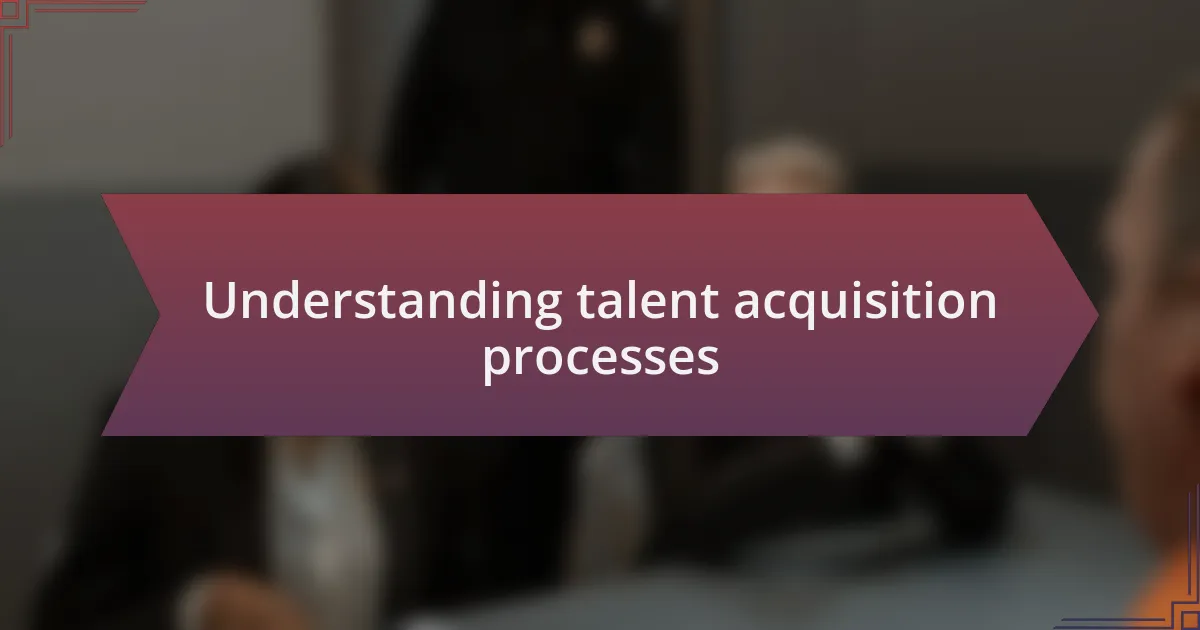
Understanding talent acquisition processes
Talent acquisition is more than just filling positions; it’s about understanding the unique needs of an organization. I remember a time when we had an urgent need for a specialized role. Instead of rushing, we spent time assessing not just the skills required, but also the cultural fit. It transformed a simple hiring process into a strategic decision that benefited the entire team.
As I navigated various talent acquisition processes, I’ve often found that clarity around job requirements is crucial. Have you ever seen a role defined so vaguely that candidates felt unsure if they even qualified? I certainly have, and it led to a pool of applicants that didn’t quite match our expectations. Clear communication isn’t just good practice; it’s essential in attracting the right talent.
Moreover, engaging with candidates throughout the process can make a world of difference. I recall receiving heartfelt emails from candidates expressing their appreciation for updates, even when they weren’t selected. It reminded me that people want to feel valued, regardless of the outcome. Isn’t it fascinating how treating candidates with respect can enhance your employer brand?
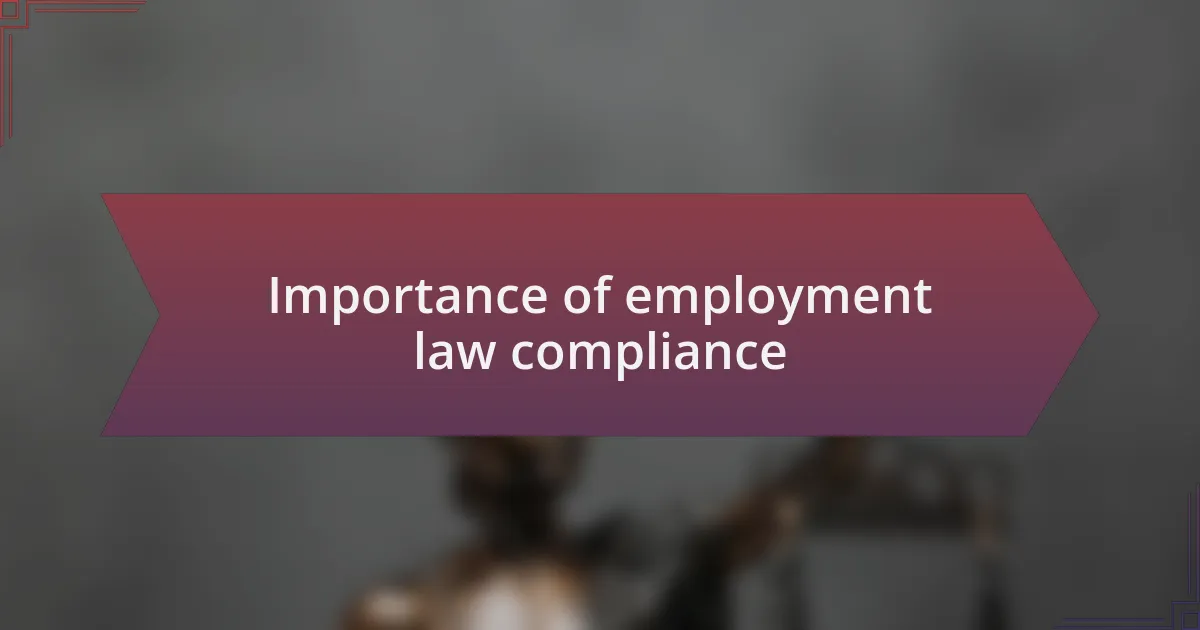
Importance of employment law compliance
Compliance with employment law is crucial for any organization. I once worked with a company that faced a significant lawsuit due to misclassification of employees. The financial implications were staggering, but it also impacted the morale of our team. It became evident that being proactive about legal compliance not only protects the organization but also fosters a sense of security among employees.
In my experience, understanding the nuances of employment law can create a more equitable workplace. For instance, during a major recruitment effort, I ensured our hiring practices adhered strictly to anti-discrimination laws. It wasn’t just about avoiding penalties; it was about doing right by candidates and creating an inclusive environment. How often do we reflect on the fact that compliance is not just about the law, but about respect for our workforce?
Keeping up with employment law changes is an ongoing process that requires commitment. I remember when a new regulation was introduced, and we had to revise our onboarding procedures. It took time and effort, but the end result was a more transparent and trustworthy hiring process. Ultimately, when organizations prioritize legal compliance, they build a stronger foundation for growth and success.
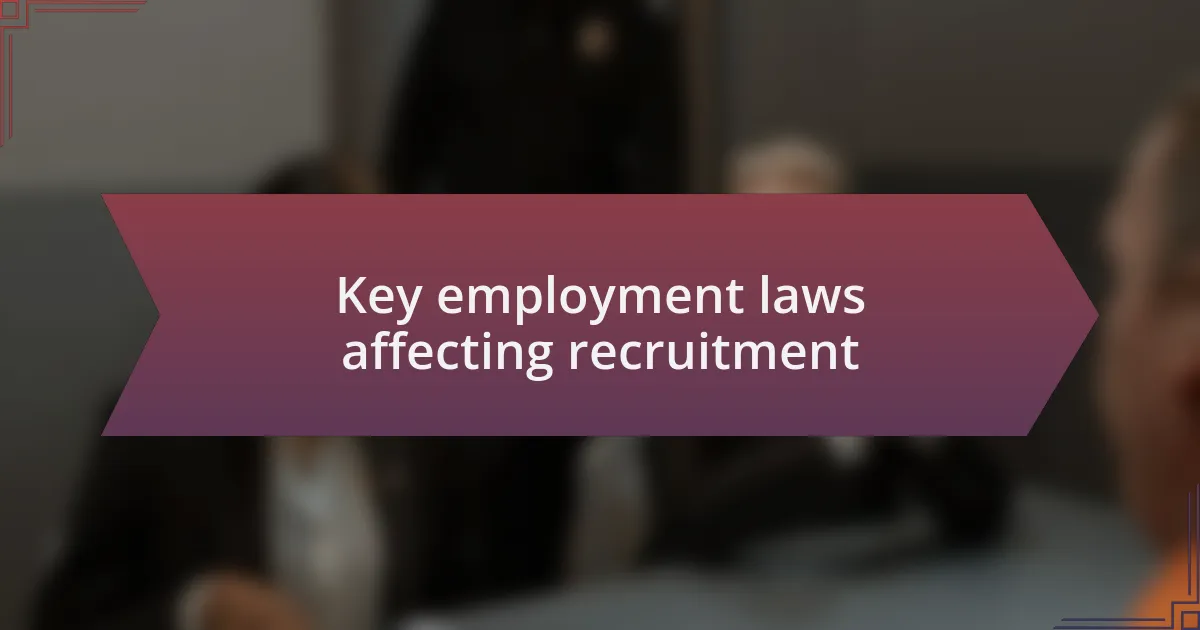
Key employment laws affecting recruitment
Key employment laws play a pivotal role in shaping recruitment practices. Take the Fair Labor Standards Act (FLSA), for instance. I recall a time when our team was hiring interns and we faced a dilemma about whether they should be paid. Navigating the stipulations around minimum wage and overtime was eye-opening; it highlighted the importance of ensuring fair compensation, fostering goodwill, and enhancing our brand reputation.
Another important law to consider is the Equal Employment Opportunity (EEO) Act, which prohibits discrimination based on race, color, religion, sex, or national origin. I remember a situation where a promising candidate was overlooked simply because they didn’t fit the traditional mold. By prioritizing EEO compliance, we turned that around and redefined our criteria, ultimately discovering diverse talent that enriched our company culture. How often do we inadvertently limit ourselves by sticking to the status quo?
Additionally, the Americans with Disabilities Act (ADA) has significant implications for recruitment. I’ve participated in training sessions that opened my eyes to accommodating candidates with disabilities. It’s not just about ticking boxes; it’s about embracing diversity and realizing that remarkable talent often lies in unexpected places. Have you ever considered how much innovation can stem from a more inclusive hiring approach?
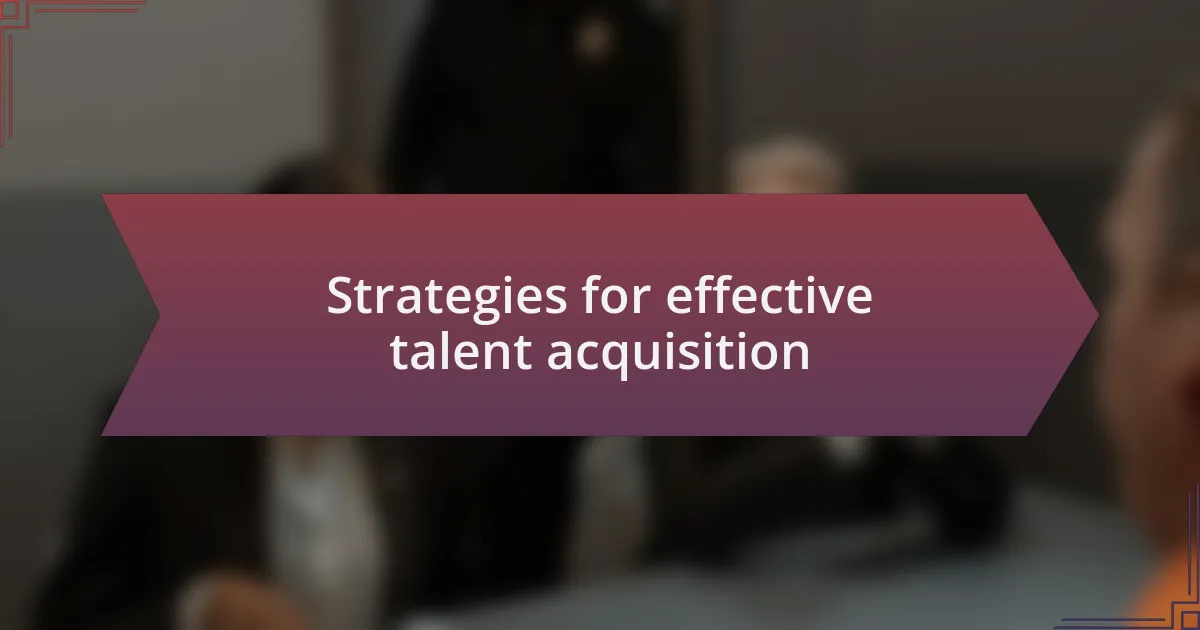
Strategies for effective talent acquisition
One effective strategy for talent acquisition is leveraging diverse sourcing channels. I’ve found that combining traditional job listings with social media platforms has yielded surprising results. For instance, a LinkedIn post about a recent project attracted an array of candidates that I wouldn’t have encountered through standard recruitment methods. It made me wonder, are we using the best platforms to showcase our workplace culture and values?
Building an authentic employer brand is another crucial strategy. I once attended a career fair where our team’s genuine enthusiasm for our mission resonated with potential hires. When candidates can see and feel the company’s culture, they are more likely to engage authentically. Have we considered how our storytelling can set us apart in a sea of monotonous corporate jargon?
Lastly, conducting structured interviews can significantly improve the validity of hiring decisions. Reflecting on a past hiring sprint, I recall how implementing a standardized set of questions helped eliminate bias and kept us focused on candidate competencies. This not only ensured fairness but also made for an efficient hiring process. Are we doing enough to standardize our evaluation criteria and set clear benchmarks?

Best practices for legal hiring
When it comes to legal hiring, it’s vital to understand the importance of compliance with employment laws. I remember the time a colleague overlooked conducting background checks due to tight deadlines, which led to complications later. It made me realize how crucial it is to have a clear process in place that follows legal requirements. Are we truly mindful of the legal landscape guiding our hiring practices?
Another best practice I’ve found effective is the use of inclusive job descriptions. In one instance, I revised a job posting to remove jargon that might deter diverse candidates. This simple change attracted a broader talent pool and highlighted our commitment to equity. How often do we take a moment to assess the language we use when attracting potential hires?
Finally, involving a diverse hiring panel can enhance the selection process. I vividly recall a hiring round where bringing in team members from various backgrounds provided unique perspectives, ultimately leading to a better fit for our culture. Do we actively consider how varied viewpoints can enrich our assessment of candidates?

Personal experiences in talent acquisition
Engaging in talent acquisition has shown me that connection matters as much as qualifications. I once interviewed a candidate whose resume was solid, but their passion for the role immediately stood out during our conversation. It made me think: do we prioritize genuine enthusiasm as much as we do hard skills?
Another aspect I’ve experienced firsthand is the importance of feedback after interviews. I remember a time when I reached out to candidates to provide constructive criticism. Not only did this foster goodwill, but it also illuminated areas where our interview process could improve. How often do we consider the candidates’ experiences after the hire?
Lastly, I’ve found that leveraging data in hiring decisions can reveal surprising insights. In one hiring cycle, I analyzed our past recruitment statistics and discovered that most successful hires came from employee referrals. This realization encouraged me to enhance our referral program, leading to an increase in high-quality candidates. Isn’t it fascinating how a little data can transform our approach to talent acquisition?
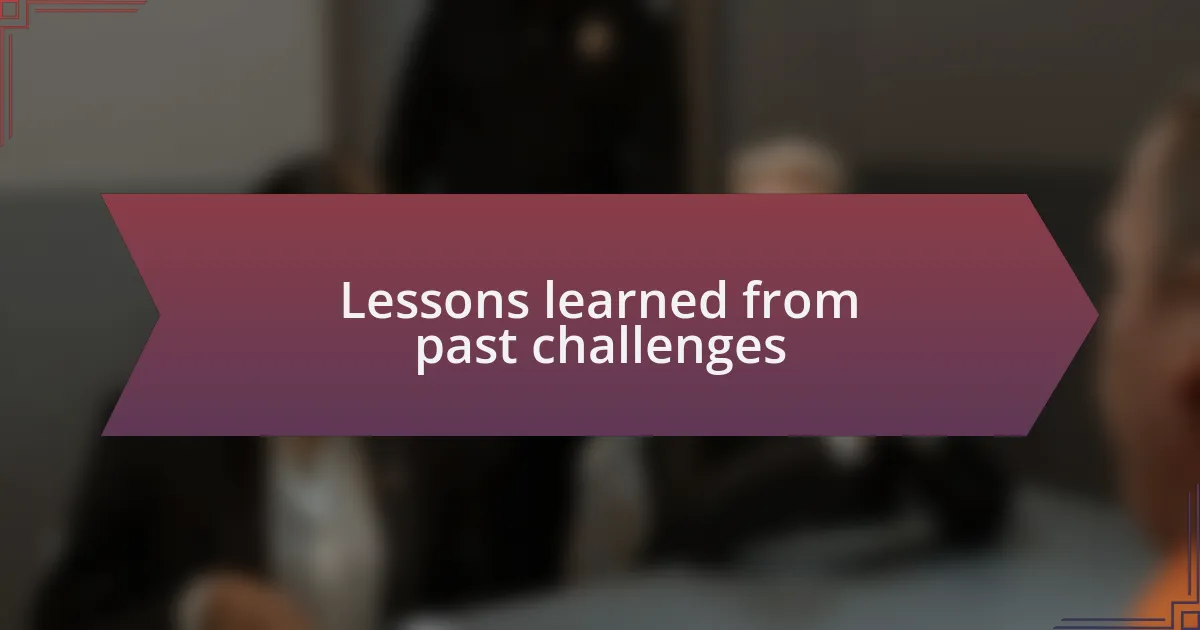
Lessons learned from past challenges
One key lesson I’ve learned from past challenges is the importance of empathy in the recruitment process. There was a time when a standout candidate didn’t get the job, and I could see their disappointment during the rejection call. That moment reinforced for me how critical it is to treat candidates with kindness, as their emotional investment is just as significant as their professional qualifications. How often do we overlook the human side of recruitment?
In another instance, I faced a lack of diversity in our talent pool, which was both perplexing and disappointing. I took a step back to analyze our sourcing channels and realized that we weren’t tapping into a wide enough range of platforms. By expanding our outreach and embracing diverse networks, we not only enriched our candidates’ mix but also cultivated a more inclusive workplace. Isn’t it empowering to see how our actions can shape a more varied and innovative team?
Lastly, I recognized the limits of a one-size-fits-all approach when discussing salaries and benefits with candidates. Initially, I approached negotiations with a standard package, but I soon realized that individual circumstances matter. By being flexible and open to discussions, I learned to tailor offers that resonated with candidates personally, which built a sense of trust and fostered stronger employer-candidate relationships. Doesn’t it make sense that personalization enhances our ability to attract top talent?